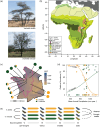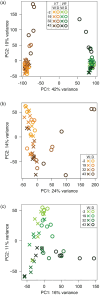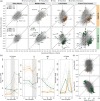Differential gene reactions reveal drought response strategies in African acacias
- PMID: 40758440
- PMCID: PMC12320966
- DOI: 10.1111/tpj.70385
Differential gene reactions reveal drought response strategies in African acacias
Abstract
Drought tolerance involves a complex series of genetic reactions that expand over time as water stress intensifies. We investigated gene expression reactions over 43 days of drought stress in two widespread African savanna trees: the umbrella acacia (Vachellia tortilis) and the splendid thorn acacia (Vachellia robusta). Using 80 transcriptomes from droughted and watered individuals over time, we developed and implemented an analytical approach to identify genes with different reactions between a watered control and droughted treatment population of each species while filtering out genes changing similarly in both populations as part of normal growth and development. Our results show that both species use similar genetic systems to modulate photosynthesis, redox homeostasis, and hormone signaling, but they activate these systems using different sets of genes and on different temporal scales relative to the intensity of drought stress. We also find strong evidence that drought tolerant umbrella acacias demonstrate a surprisingly limited and relatively passive transcriptional response to drought stress, while splendid thorn acacias attempt to actively combat drought stress and maintain a steady state of growth and photosynthesis. Our study provides the first transcriptomic analysis of African acacias and a new model for investigating transcriptomic reactions over long periods of stress.
Keywords: Fabaceae; Vachellia robusta; Vachellia tortilis; acacia; differential gene expression; differential gene reaction; drought stress; savanna; transcriptome; water use efficiency.
© 2025 The Author(s). The Plant Journal published by Society for Experimental Biology and John Wiley & Sons Ltd.
Conflict of interest statement
The authors declare that they have no competing interests.
Figures





Similar articles
-
Integrating differential expression under drought with gene family expansion unique to drought-tolerant species prioritizes candidate genes for drought adaptation in Brassicaceae species.BMC Genomics. 2025 Jun 19;26(1):571. doi: 10.1186/s12864-025-11737-0. BMC Genomics. 2025. PMID: 40537742 Free PMC article.
-
Genome-wide and transcriptome analysis of PdWRKY transcription factors in date palm (Phoenix dactylifera) revealing insights into heat and drought stress tolerance.BMC Genomics. 2025 Jul 1;26(1):589. doi: 10.1186/s12864-025-11715-6. BMC Genomics. 2025. PMID: 40597593 Free PMC article.
-
Differential photosynthetic responses to drought stress in peanut varieties: insights from transcriptome profiling and JIP-Test analysis.BMC Plant Biol. 2025 Jul 25;25(1):957. doi: 10.1186/s12870-025-06984-y. BMC Plant Biol. 2025. PMID: 40713488 Free PMC article.
-
Eliciting adverse effects data from participants in clinical trials.Cochrane Database Syst Rev. 2018 Jan 16;1(1):MR000039. doi: 10.1002/14651858.MR000039.pub2. Cochrane Database Syst Rev. 2018. PMID: 29372930 Free PMC article.
-
Interventions to reduce harm from continued tobacco use.Cochrane Database Syst Rev. 2016 Oct 13;10(10):CD005231. doi: 10.1002/14651858.CD005231.pub3. Cochrane Database Syst Rev. 2016. PMID: 27734465 Free PMC article.
References
-
- Anderson, T.M. , Morrison, T. , Rugemalila, D. & Holdo, R. (2015) Compositional decoupling of savanna canopy and understory tree communities in Serengeti. Journal of Vegetation Science, 26, 385–394. Available from: 10.1111/jvs.12241 - DOI
MeSH terms
Grants and funding
LinkOut - more resources
Full Text Sources

